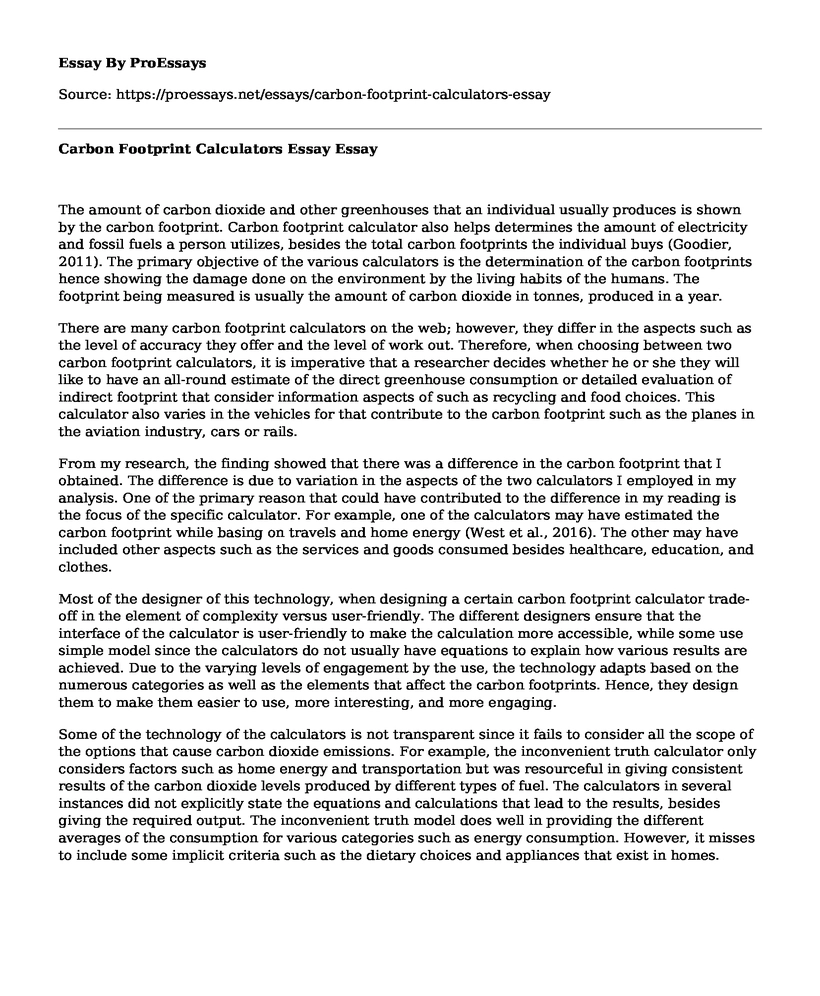The amount of carbon dioxide and other greenhouses that an individual usually produces is shown by the carbon footprint. Carbon footprint calculator also helps determines the amount of electricity and fossil fuels a person utilizes, besides the total carbon footprints the individual buys (Goodier, 2011). The primary objective of the various calculators is the determination of the carbon footprints hence showing the damage done on the environment by the living habits of the humans. The footprint being measured is usually the amount of carbon dioxide in tonnes, produced in a year.
There are many carbon footprint calculators on the web; however, they differ in the aspects such as the level of accuracy they offer and the level of work out. Therefore, when choosing between two carbon footprint calculators, it is imperative that a researcher decides whether he or she they will like to have an all-round estimate of the direct greenhouse consumption or detailed evaluation of indirect footprint that consider information aspects of such as recycling and food choices. This calculator also varies in the vehicles for that contribute to the carbon footprint such as the planes in the aviation industry, cars or rails.
From my research, the finding showed that there was a difference in the carbon footprint that I obtained. The difference is due to variation in the aspects of the two calculators I employed in my analysis. One of the primary reason that could have contributed to the difference in my reading is the focus of the specific calculator. For example, one of the calculators may have estimated the carbon footprint while basing on travels and home energy (West et al., 2016). The other may have included other aspects such as the services and goods consumed besides healthcare, education, and clothes.
Most of the designer of this technology, when designing a certain carbon footprint calculator trade-off in the element of complexity versus user-friendly. The different designers ensure that the interface of the calculator is user-friendly to make the calculation more accessible, while some use simple model since the calculators do not usually have equations to explain how various results are achieved. Due to the varying levels of engagement by the use, the technology adapts based on the numerous categories as well as the elements that affect the carbon footprints. Hence, they design them to make them easier to use, more interesting, and more engaging.
Some of the technology of the calculators is not transparent since it fails to consider all the scope of the options that cause carbon dioxide emissions. For example, the inconvenient truth calculator only considers factors such as home energy and transportation but was resourceful in giving consistent results of the carbon dioxide levels produced by different types of fuel. The calculators in several instances did not explicitly state the equations and calculations that lead to the results, besides giving the required output. The inconvenient truth model does well in providing the different averages of the consumption for various categories such as energy consumption. However, it misses to include some implicit criteria such as the dietary choices and appliances that exist in homes.
Conclusion
The behavioral changes had different impact whereas some had significant effect while others had a small impact due to the level of significance emphasized on the rest of the world's consumptive attitude. In some instance, people decide to change the number of miles they drive, which is insignificant when compared to the number of individuals who are still driving in the worlds. One major factor that has contributed to this is the design of the calculators since some focus on the type of food chosen by various people while others emphasized the number of miles driven. No single calculator considered all the scopes of carbon footprint. The design differences are based on the assumption that the creators focused more on the criteria they believed to be the most important hence making it's biased. For example, when a calculator asks a question such as the annual income of a specific individual, it assumes that more determines the amount of energy a person consumes.
References
Goodier, C. I. (2011). Carbon footprint calculator. SAGE Publications.
West, S. E., Owen, A., Axelsson, K., & West, C. D. (2016). Evaluating the use of a carbon footprint calculator: communicating impacts of consumption at the household level and exploring mitigation options. Journal of Industrial Ecology, 20(3), 396-409.
Cite this page
Carbon Footprint Calculators Essay. (2022, Aug 23). Retrieved from https://proessays.net/essays/carbon-footprint-calculators-essay
If you are the original author of this essay and no longer wish to have it published on the ProEssays website, please click below to request its removal:
- Impact of the Atmospheric Carbon (IV) Oxide on Forest Ecosystems
- Carbon Footprint Calculators Essay
- Essay Sample on Making the City of Atlanta 100% Green
- Use of Alternative Energy to Reduce Global Warming - Research Paper
- Iron Mountain Mine: A Historical Copper and Mineral Pit of Northern California - Essay Sample
- Research Paper on Food Waste: A Major Contributor to Climate Change
- Paper Example on Simple Ways to Reduce Waste & Save Money







